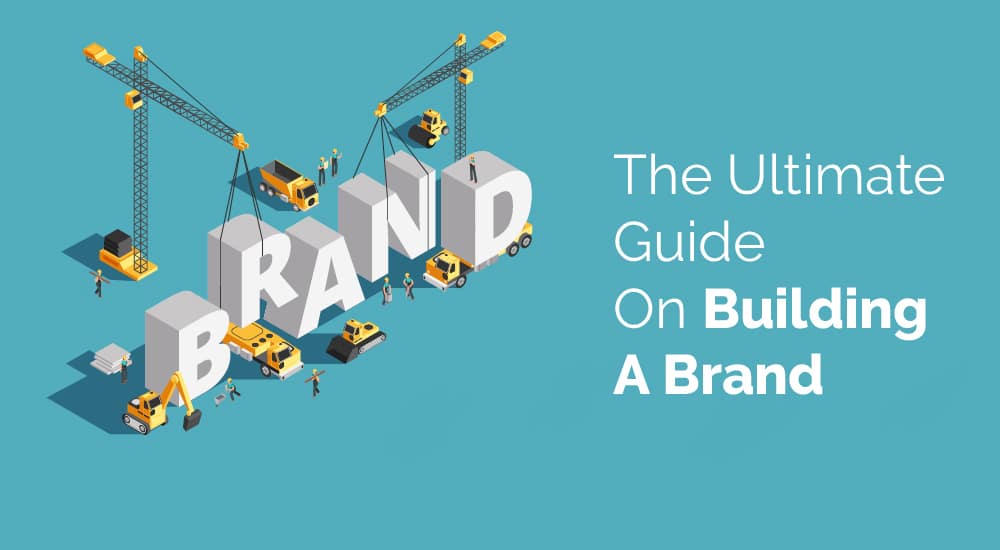The Ultimate Guide to Building a Brand

Introduction

As consumers, when we’re asked to think of a brand we tend to leap straight to logos and slogans.
Everyone can pick out a Coca-Cola at the store because they recognize the logo and color scheme.
Likewise, you know exactly what kind of food you’re getting when you pass beneath the golden arches of McDonald’s.
Those logos, and slogans, and color schemes, are known as visual assets. They are the things that the consumer sees.
However, there is an awful lot more to branding than a bright logo and a snappy slogan.
To create and build a successful brand, you need to know your business and your customer inside and out.
You need to understand the mission, the vision, and the values of your business before finding out how your customer base thinks and feels.
Your brand should be all-encompassing. It should follow the customer through their interaction and experience with your company.
From the first moment they step into a store, till the moment they dispose of your wrapping, you want the customer to feel and know the values, vision, and mission of your company or business.
In this guide, we’re going to explore every aspect of branding. We’ll take you through conception, development, realization, management, and even rebranding.
We’ll help you work out how to make the most of your brand and how to avoid making branding mistakes.
Before we dive into the process, let’s take a little look at what a brand actually is.
What Is A Brand?

In the simplest terms, a brand is something that distinguishes one maker’s product from another.
Usually, a company’s brand contains its logo or symbol, slogan, name, color palette, brand voice, and company values.
It is, in essence, the perception created in the minds of consumers.
Let’s take a look at an example, The Walt Disney Company.
When you see that swirly, cursive writing you know you’re in for something magical. Whether you’re sitting down to watch a film, visiting a theme park, pulling on a t-shirt, or walking into a Disney store, you know what to expect.
It’s not because of the logo, that’s more of a memory aid. Your perception of that company is built on your experience with the Walt Disney Company.
The friendliness and energy of their staff in the parks and stores create positive, enjoyable memories of your interactions.
The funny, loveable, animated sidekicks present in most Disney movies, make you chuckle and smile when you think of Disney.
The hyperreal magic of the parks makes you feel warm and fuzzy inside just thinking about being in the parks.
None of these memories or experiences are created by a logo. The logo is simply present in all of these experiences. It creates a shortcut to those memories and feelings.
Hence, when you see the Disney logo on a mug or a t-shirt at Target, you’re inclined to purchase it because you expect great things from the company.
That is exactly what a brand should do. It should create a series of positive thoughts, feelings, and emotions that consumers can connect to your company via your visual assets.
A company that only focuses on logos and slogans at the expense of customer experience, will not create a successful brand.
What is Brand Identity?

If a brand is a perception in a person’s mind and branding is the act of cultivating that perception, what is a brand identity?
The brand identity is that memory aid created by the company to help its customers associate the brand with the company.
Your brand identity is composed of those tangible visual elements like the logo, slogan, color schemes, and fonts.
Your brand identity needs to be intrinsically linked to your brand. As such, before you go ahead and create a logo or choose a color palette, you need to identify your company values and mission.
We will take a closer look at how to link your brand identity to your brand later.
What I’m trying to get at here is that your brand identity needs to reflect your business’s values, vision, and mission.
You do that by making active and informed choices about logos, colors, typography, and other visual elements.
You see, your customers have psychological connections with colors, fonts, images, and visual organization. Our brains are designed to use these shortcuts to help us process the world more effectively.
Just think for a second, what the color green evokes for you.
Odds are it’s something nature-based or it’s money, right?
Let’s think about a brand identity that uses the color green. Subway for example.
Subway’s logo is its name colored green and yellow. Its tagline is ‘Eat Fresh.’
That green color makes most people think of nature so when it’s combined with the tagline, we already have a natural, fresh perception bubbling away in our brains.
We don’t even have to know anything about the company to get an idea of the values and mission.
In a way, brand identities are just elaborately coded messages that work on a subliminal level as well as a more conscious level.
How to Build a Brand

Ok, strap in. We’re going to take you through the branding process in this section. We will go from start to finish and even look at rebranding.
Remember that this guide is comprehensive but not exhaustive. You can literally do a degree in each section of this process.
Take this guide as a place to start your learning or a hand crib sheet for post-learning.
1. Market Research

Before you go anywhere near a logo, company name, or mission statement, you need to know what your target audience responds to.
The demographics of your target audience will change the way they respond to your brand image and mission statement.
For example, compare the online bank Ally Bank, with a traditional bank like JP Morgan Chase.
The first thing you notice is the different color schemes.
Ally has used purple which has connotations of richness and royalty as well as creativity. It reflects the bank’s tagline which is ‘Do it right.’
The royalty and riches connotations suggest that the bank is ‘doing right’ with your money by increasing it.
The creative aspect of the purple coloring suggests that the bank is ‘doing right’ by doing banking another way.
JP Morgan Chase uses a deep navy blue. Blue is the most universally appealing color. In general, it tends to make people feel cool, calm and collected. Deep blues are particularly effective at creating a professional, secure brand image.
This color again reflects the company’s tagline which reads ‘The right relationship is everything.’
Another thing to look at is the logo.
Both companies use their name as their logo, but they use very different fonts.
JP Morgan Chase uses a serif font. This font category includes typefaces like Times New Roman. These fonts suggest a classical, reliable business.
Ally uses a sans serif font which is less fussy and cleaner. Sans-serif fonts evoke a sense of directness and modernity.
Even though both brands are banks, their approach to their brand identity is very different. This is because their target audience is different.
Ally’s target audience is millennials. These people are far more likely to use online banks compared to older generations. As such, Ally created its brand around the things millennials find appealing.
They went for a friendly and approachable logo with soft edges. They chose a purple color scheme to reflect the luxury and riches that millennials are aspiring to reach. The tagline, ‘doing it right’ reflects the ethical concerns and considerations often held by that generation.
JP Morgan Chase, on the other hand, targets older audiences. They chose a dark blue palette to suggest security and stability which is highly prized by people who have lived through at least 2 financial crises.
Their tagline, ‘the right relationship is everything’ speaks to people who are used to in-person banking. It suggests a personal touch that is prized by older customers.
Even though these banks offer similar products and services, they took their brand in very different directions. This is because they researched their target market beforehand.
You need to do the same!
When it comes to conducting market research, you don’t have to drag focus groups in for interrogation. At least not straight away.
One of the best ways to conduct some market research is to act like a consumer. Search for your product or service and see what comes up. Look at which brands people respond to, find out how your competitors brand themselves.
Once you’ve scoped out the competition, approach your target audience and ask them about the brands they use in your area. Ask what draws them to those brands, how they think and feel about those brands.
You can also do a bit of undercover research by joining consumer pages, subreddits, and social media groups. Listen in on the discussions your audience is having. See what key principles stick out to them.
At the end of your market research, you should have an understanding of your target audience. You should know what sort of things they like, what they want from a product or service, and also a basic understanding of how they speak and describe themselves and the products they use.
2. Find your Focus

Now that you know your target audience, you need to get to know yourself.
Finding your company focus is all about identifying the features and practices that make your product or service worth using.
Once you find your focus you can combine it with your market research to create visual assets.
Drilling down into your product can be tough. Once you start, you can find yourself getting lost in semantics and existential crises.
Try the following exercises to help you narrow down your brand focus.
Create a positioning statement. This statement is just one or two lines that place your product or service firmly in the market.
You can create one by simply filling in the blanks:
We offer [product] for [target audience] in order to [what the product does.] Unlike [competitors] we [unique selling proposition.]
As an example, you might write:
We offer comfortable and stylish shoes for professional men to help them stand out from the crowd. Unlike Average Joe Shoes, we donate a pair of shoes to low-income kids with every purchase.
You won’t necessarily put this statement on your marketing materials, but it helps you identify the essentials of your business.
You can use this as the basis of your mission statement.
Establish your tone. The tone of your brand will guide all your visual assets, social media platforms, and brand voice.
Try to imagine your brand is a person. How would they act and speak? What would they be like as a person? What kind of customers would they want to attract?
With that in mind, write down 3-5 words that describe your brand. Try to choose personality traits rather than standard adjectives. It will give you a better sense of your brand.
One of the best ways to establish and develop the tone and personality of your brand is to make a mood board.
Don’t roll your eyes! It can genuinely help.
This mood board should focus on personifying your brand rather than product comparisons.
Pick images, quotes, colors, fonts, and patterns that reflect your brand not your products.
Later, when making decisions about visual assets or communications, keep your mood board handy. This will help to remind you of your tone.
Write your mission, vision, and value statements.
We’ve mentioned mission, vision, and values a few times in this article. It’s time to define them.
Your value statement should identify and highlight what is important to your business. They should define your company’s culture and beliefs.
Often, value statements pick out words that reflect the company’s priorities. This might be something like ‘value,’ ‘quality,’ or ‘excellence.’ However, more socially aware companies might include things like ‘inclusivity,’ ‘social responsibility,’ or ‘environmental impact.’
Your value statement should explain these buzzwords and how they relate to your business.
Your mission statement should be an action-based statement that essentially explained why your business exists and what its short term aims are.
You can use the position statement you wrote earlier as a basis for your mission statement.
Tesla’s mission statement, for example, reads: To accelerate the world’s transition to sustainable energy.
It succinctly explains why Tesla exists and what its short term aim is.
Your vision statement is a declaration of the long term aims. It should explain where your company will be when it achieves its mission. It’s an aspirational target.
If we take a look at the following example from Microsoft you can see how the three statements support each other.
Their values inform their mission which in turn helps them achieve their vision.
3. Choose a Name

Choosing a name is the first big choice you’ll have to make.
Your business name is going to be all over your branding materials, it’ll be pervasive throughout your business.
Hence, it needs a good deal of thought put into it.
Your name should be easy to remember, hard to imitate, and impossible to confuse.
That last one is key. You don’t want potential customers ending up in someone else’s store because they mixed up the names!
When it comes to creating a business name, you have a bit more flexibility than naming a child for instance.
Here are our top tips:
- Brainstorm everything – This activity is all about casting your net wide. You might end up writing 100 bad names but it will help you get to that 1 you love.
- Combine words – create a list of words that describe or explain your business then experiment with mashing them together.
- Remove a letter – this is quite a popular naming method. Think, Tumblr and Flickr.
- Acronyms – If you have a name you love but it takes too long to say, try reducing it to an acronym. Examples of acronym names include HBO, NBC, CVS, BMW.
- Use a name generator – There are lots of business name generators available online. Check them out and see what you land on. If you don’t like the name you can simply refresh the generator!
One thing to be mindful of is domain names. Before you settle on a business name search for the domain of the same name. Ideally, you want it to be free.
Your domain doesn’t have to be exactly the same as your name, but you should check what’s available.
4. Taglines

Your tagline or slogan isn’t necessarily static.
It can change and morph as your marketing angles and promotions change.
In the beginning, it’s good to have a tagline that helps consumers understand your business and brand.
Your tagline or slogan needs to be short and snappy. It shouldn’t be more than one line and it needs to be easy to remember.
There are different ways of approaching your tagline. Here are some ideas:
- Metaphor or simile – You could get creative and make a metaphor or simile of your product or service. A delivery service might use the tagline ‘like lightning’ for example.
- Literal – If you’re not into metaphor, go literal. Tell your consumer what your product is. Examples might include ‘Your local bookstore,’ ‘Premium fashion boutique.’
- Establish your ethos – Nike’s famous ‘Just do it’ is persuasive and memorable because it embodies the attitude of the company and the customers.
- Make it rhyme – this technique is less popular nowadays. Nonetheless, rhymes help consumers remember your slogan. Think about the Pringles slogan ‘Once you pop, you can’t stop.’
- State your USP – use your slogan to tell your consumers what’s unique about your product. BMW’s slogan Designed for driving pleasure tells you straight away what’s special about this brand.
5. Visual Assets

Now that you understand your customers and your business you can start creating your visual assets.
These are your logo, your font, your color palette, and any other marketing materials you’ll need.
Let’s start with logos.
You only have to look at the success of The Logo Board Game and copycat apps to realize that logos are incredibly important to branding.
In most cases, the logo will be how your customers initially identify your brand. Your brand name often comes in second.
Designing a logo can be difficult if you’re not artistically inclined. Luckily there is a wide range of logo makers available online to help you out.
Just like when you’re creating a name, you should brainstorm lots of ideas. Try different styles and designs.
There are 7 main logo styles that you can use. Each can be adapted to match your business’s personality.
The 7 logo styles are:
- Lettermarks – Essentially, these are monograms. Think about the HP logo or the CBS logo. Lettermarks are great for minimalist designs but not so great at explaining your concept.
- Wordmarks – These are logos that use the company name. With these kinds of logos, typography is important.
- Pictorial – As the name suggests, these are picture logos. Think Apple. Pictorial logos are recognisable as objects or images and can be as simplistic or complex as you like.
Usually, pictorial logos are combined with wordmarks to help build brand recognition. Apple no longer needs to include its name because we all know the brand! - Abstract – These logos have a pictorial element but they are not identifiable as objects or images. These tend to be more unique and create a feeling or emotional response to your business.
- Mascots – Commonly used by sports teams, mascots are usually fun, whimsical, or endearing. They give your consumers something to connect with.
- Combination Mark – Pretty self-explanatory, this kind of logo combines two different kinds. Usually, you see pictorial logos combined with wordmarks. Burger King is a great example.
- Emblem – These kinds of logos are pretty popular with hipster businesses! They tend to look like badges or crests and they combine pictures, words inside of a badge or crest shape.
Your choice of font is as important as your logo. Your fonts should be uniform across the business so that your customers feel like every bit of text they read belongs.
Choosing a font for your logo or your communications can be tricky. You want the font to be easy to read, but interesting at the same time.
There are four basic kinds of font. Each has its own unique characteristics and feels.
- Serif – A serif is the name given to the little extension lines you get on fonts like Times New Roman. They are those extra bits on the ends and tops of letters that make it feel fancy.
Serif fonts are great for vintage, classic, or serious brands. They create a sense of grandeur. - Sans-serif – literally translating as without serifs. These fonts tend to be more rounded, modern, and minimalist.,
They are hugely versatile and can work for lots of different kinds of brands. - Script – These fonts look handwritten. They are more whimsical and tend to be perceived as more feminine.
Script fonts can also create a rustic or handmade feeling for your brand. - Display – These are highly stylized and usually decorative fonts designed to grab people’s attention.
They are commonly used for logos but are less common for large bodies of text.
You may end up combining one or two of these font styles. For example, it’s common to use a script font or display font for a logo but then choose a serif or sans-serif font for bodies of text.
Finally, color. Color is massively important to your brand. Our brains are designed to decode colors based on our social and cultural norms.
Choosing a color palette can affect the target audience you attract and the preconceptions they have about your brand.
Monochromatic designs are rare. Usually a brand will combine two or more colors. When you’re combining colors you have 3 choices.
- Complementary colors – These are colors that sit opposite each other on the color wheel. They can give your branding an active or dynamic feel.
- Analogous – These colors sit side by side on the wheel. If you want a softer, harmonious feeling go for this method.
- Triadic – You get to pick three colors from each third of the wheel. You want the colors to be equidistant apart. Triadic color schemes are bold and eye-catching.
Each color is associated with different thoughts, feelings, and emotions. When choosing your color scheme, you want to think carefully about how you want your brand to be perceived.
Take a look at the diagram below to see the common color associations. It also highlights the brands that use those colors.
When it comes to choosing a color scheme, you’ll need to be mindful of all the different places this color scheme will be applied.
Neon green might be attention grabbing on a leaflet or trade show banner, but it might be rather overwhelming when decorating a store.
Similarly, neutral colours might be clean and professional on a business card or store interior, but it will look a bit bland on trade show graphics and promotional materials.
6. Find your Voice

You’re almost ready to apply your branding but there’s one final thing to do.
Figure out how your brand would talk if it could.
Whenever you communicate with your customers be it through your website, socials, or emails you need to use the brand voice.
It will help people understand and anticipate the exchange they’re going to have.
You should again consult your market research to figure out how your target market speaks and thinks.
Some audiences would balk at being addressed by their first names. Others would find it stuffy and odd to be called Mrs or Mr.
7. Apply your Brand

Now that you have your brand all mapped out, it’s time to use it!
You need to apply your branding across every aspect of your business.
This includes websites, social media, leaflets, stores, packaging, advertising materials, trade show banners and graphics, and even your employees.
Promotional and advertising materials like trade show graphics, leaflets, and advertisements need to match your static assets like your website and social media. This is because you want customers to know that they’ve arrived at the right website or page.
If your socials or website are branded differently than your promotional material there will be confusion which could lose sales or customers.
This uniform application is important because it reinforces the brand and associations with your company. It also reduces the chance of jarring customer experiences if everything is seamlessly integrated.
Don’t forget to include your vision, mission, and value statements where appropriate. They are as important as your logo and color scheme.
Also, make sure that any copy is written using that brand voice we talked about.
Brand Awareness

With your brand out there in the world, it’s time to make sure people see and recognize your brand.
The ultimate goal of brand awareness is for your brand to become a proprietary eponym. You know how when you’ve had an accident you look for a Band-Aid to make it better? Or how when you need a pen you ask for a Biro?
Those are both brand names but they’re more common and familiar to us than the real names of those objects.
To get to that point, you need to create a large amount of brand awareness.
Brand awareness is slightly different to brand recognition. The latter is when consumers can identify your product or service from your logo, slogan, or color schemes.
Brand awareness is a deeper connection. It’s when customers can make choices and decisions based on your brand.
For example, you might recognize the golden arches and instantly think of McDonald’s. That is brand recognition.
However, the choice to get a Mcdonald’s over another brand because you know they do good food is brand awareness.
Brand awareness encompasses the feelings, thoughts, and emotions connected to those brands. It is what ultimately makes a customer choose your brand over another.
The key to creating brand awareness is to get your brand out there. Make it pervasive but not invasive. You don’t want to ram your brand down people’s throats.
Here are some ideas for creating brand awareness. It’s not a full list, but check out articles like this or this for more ideas.
- Use social media – You need to take advantage of all that social media has to offer. As well as working on your own social pages, get some social media advertising on the go.
Facebook and Instagram allow you to run specific brand awareness ads that focus on your brand rather than specific products. These are excellent for raising brand awareness. - Get reviews – Part of your brand relies heavily on what users think of your product or service. Encourage customers to leave reviews on your socials, websites, and products.
If you have the budget, try influencer marketing. Essentially, you pay influencers to use and review your product. Their influence helps to spread brand recognition and awareness. - Local links – When you’re starting out, it’s a great idea to use your local area for initial brand awareness. Sponsor local teams or events to get your brand out there.
Partner up with other companies to share some of their brand recognition.
Rebranding

Before we leap into rebranding, it’s important to check whether or not you need to rebrand.
Brands are dynamic, living things. They can grow and change with you. Sometimes you need to expand your brand rather than overhaul and do a complete rebrand.
That being said, there are times when you need a rebrand. In those cases, you should follow the steps below.
- Identify the reason – You need to have a definite business reason for your rebrand. Changing things up because you fancy a new color scheme is a waste of money.
Rebranding to draw in new customers differentiate from a competitor, or because you need to simplify your brand are valid reasons. - Conduct market research – You need to be aware of the competition. Figure out what is working, what your customers like and dislike.
- Decide whether you need a full rebrand or just an update – Sometimes you just need a bit of a refresh rather than a full overhaul.
Google has changed the design of their wordmark logo 6 times. The changes have been small but nonetheless noticeable. This didn’t necessitate a whole rebrand, just an update.
- Redefine and redesign – Follow the same protocol as if you were creating a new brand. Do your statements and your visual assets. Incorporate the market research you conducted.
- Apply your brand – You need to be extra careful when applying your new branding. Make sure you scrub your assets of your old branding and blanket them with your new brand.
You don’t want to confuse your customers and muddy your brand identity. - Shout about it – Rebrands aren’t something you do quietly. When you’ve finished your rebrand you need to make sure your customers know about it. That way they won’t be confused when they see your new logo or colors.
Have a launch event that showcases your new branding. Make some freebies to give away and get the branding out there. If you’re a digital business, you could try running events or competitions.
Mistakes to Avoid When Building a Brand

We know that we’ve covered a lot of different topics in this article. All that information is going to be swimming around your head right about now.
To streamline things and give you a bit of a cheat sheet, we’ve pulled together some of the most common branding mistakes so you know what to avoid.
- Ignoring market research – This is a big no no. There are so many companies and businesses that create a logo and identity without thinking about their customer base.
If you’re lucky, your target audience will be ambivalent towards your brand. In many cases, you can actively annoy or turn off your customer base.
You need to appeal to your target market so do your research! - Copying competitors – Making your branding too similar to a competitor will hamper your brand recognition. You need to be unique and easily identifiable.
During your research, you need to look at your competitors’ branding and figure out what they are doing well and what needs improvement, but you cannot do exactly as they do. - Focusing solely on visual assets – As we’ve mentioned previously, logos, color schemes, slogans, and typefaces are important but they’re not the only important thing.
You need to spend as much time cultivating your brand culture as you do working on your visual aspects.
Make sure that employees know how to act and respond to customers. Make sure they know the company’s values, mission, and vision.
Work on meeting your brand values. If that involves social enterprise, set it up. If your values focus on making environmental changes, be active in that pursuit.
You need to cultivate your brand at every opportunity.
- Inconsistency – The public can’t recognize your brand if you can’t! Make sure you know exactly what your brand is and that it’s applied consistently across all media.
Inconsistencies can kill brands. If you have several different logos, your customers won’t know which to associate with you. Even if you have different sections or areas, try to stick with one main logo.
Keep it consistent down to the fonts you use. Again, it just helps customers make associations and connections.
Your voice also needs to be consistent in all your communications. If you’ve gone for a fun and playful voice, don’t suddenly switch to a formal and serious tone in your emails. It will confuse your brand and your message. - Ignoring feedback – One of the key things to remember is that you can’t get too attached. You might think your brand is amazing and flawless, but if your consumers don’t respond you’ll need to change.
If you only acknowledge positive feedback, you won’t get a full, rounded response. You have to develop a thick skin and learn to take constructive criticism.
Final Thoughts

Brands, branding, and all the related disciplines are enormous areas of knowledge, understanding, and skill. You can’t hope to be an expert by simply reading this article.
What we have tried to do is give you a clear overview of the branding process from start to finish. That way you have a basic understanding of each step.
Hopefully, you are able to appreciate the complexity and importance of building a brand for your business.
If you can take away one thing from this article, I’d hope that it would be the fact that a logo is not enough!
Successful brands are well rounded and all-encompassing. Every piece of communication, every physical and digital space you own needs to reflect your branding.
From business cards to trade shows, emails to personnel. You and your company need to live and breathe your brand. Let us know if we can help with your trade show booths and graphics.
